James Cameron Terminator 2: Judgment Day (Part I)

Written by
James Cameron
and
William Wisher
When I first saw Terminator 2: Judgment Day, I knew it was an extraordinary film. Not only were the special effects extraordinary, but the thoughts and ideas behind the film were marvelous. Especially, the last line: Sarah Connor (played by Linda Hamilton) observes that “if a machine can learn the value of a human life, maybe we can too.” That line was so profound, so moving, it just blew me away.
I didn’t know too much about James Cameron when I first saw Terminator 2, though I had been extremely impressed with his first major success, The Terminator (1984). I knew he was an innovative filmmaker with extraordinary ability, and his films always had an interesting premise, whether it was The Terminator or Aliens, or in his later films, The Abyss, Terminator 2: Judgment Day, True Lies, or Titanic.
I wanted to learn more about him so I called and set up an interview. The name of his company is Lightstorm Entertainment, and I found his interview to be so interesting that I decided to present it in two parts. What follows is Part I.
“I’ve always liked science,” he began, “and when I first started out, I thought for a time that I might want to become a marine biologist, or physicist. But I also liked to write, so I was pulled in a lot of different directions.
“I loved the idea of being in another world, and anything that could transport me to another world is what I became interested in. Gradually, I saw that the medium of film could accommodate both my interests in science and art. And, with the help of a book called Screenplay: The Foundations of Screenwriting, I figured out how to write a screenplay. So, I sat down with a friend and we wrote a little ten-minute script. We raised the money to make it and shot it in 35mm; it had all these effects and models and matte shots, all this wild kind of stuff.
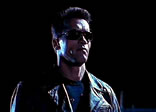
(I asked about his background in special effects, he told me he was completely self-taught. I asked him to explain.)
“I’ve always known that people seek out the information and knowledge they need. They seek it and find it. It’s like a divining rod to water; nobody will give you the pathway. It’s something you have to find for yourself.
“So, I’d go down to the USC library and pull any thesis that graduate students had written about optical printing, or front screen projection, or dye transfers, anything that related to film technology. That way I could sit down and read it, and if they’d let me photocopy it, I would. If not, I’d make notes. I literally put myself into a graduate course on film technology. I didn’t have to enroll in school because it was all there in the library. I’d set it up to go in like I was on a tactical mission, find out what I needed to know and take it all back. I had files and files stacked on my desk of how all this stuff was done.
“Because of my strong background in special effects, my natural inclination was to lean toward science fiction. But realistically, I knew the most money I could probably raise to make a picture would be $3 or $4 million. So I knew I would have to write a contemporary story in a contemporary location. So I started putting things together. I’ve got effects, I want it to be science fiction, and I want it to be a contemporary story.
“So how do I inject the fantastic element into a contemporary story? I didn’t want to make a fantasy, like a magic mirror communication with another dimension. I wanted it to be gritty realistic, kind of hardware based, true science fiction, as opposed to fantasy science fiction.
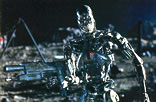
“Then I hit on the idea of the future being determined by something that’s happening now; someone who’s unaware of the results of their actions finds out they have to answer for those actions – in the future. So what’s the most extreme example of that I can think of? If the world has been devastated by nuclear war, if global events are predicated on one person, who is the least likely person you can imagine? A nineteen-year-old waitress who works at Bob’s Big Boy (a fast-food restaurant in Southern California).
“So I started creating some juxtapositions that seemed interesting to me. This incredible nightmare would be glimpsed through little windows of contemporary reality.
“The story evolved from that.
“I started thinking about the film in two stages. In the first stage the future sends back a mechanical guy, essentially what The Terminator became, and the good guys send back their warrior. In the end, the mechanical guy is destroyed. But up there in the future, somewhere, they say, well, wait a minute, that didn’t work; what else do we have? And the answer is something terrible, something even they’re afraid of. Something they’ve created that they keep locked up, hidden away in a box, something they’re terrified to unleash because even they don’t know what the consequences will be – they being the machines, now in charge of the future.
“And that thing in the box becomes a total wild card; it could go anywhere, do anything; it’s a polymorphic metal robot that is nothing more than a kind of blob. I saw it as this mercury blob that could form into anything. It’s powers were almost unlimited, and even in the future, they couldn’t control it.
“That scared me. Just sitting there writing the story scared me.
“Technically, I didn’t want the robot to look like a man in a suit. If this robot was something that was supposed to fit inside a human form, we could not accomplish that visual by putting it outside a human form, then trying to imagine that it was also inside. It just wouldn’t work. Nobody had ever created a robot that wasn’t a suit. Silent Running and Star Wars had been done a few years earlier, and since then there had been a whole history of film robots that were basically guy-in-suit robots. So for me, the special effects challenge was getting something believable that could have existed inside a human form. That was the real challenge.
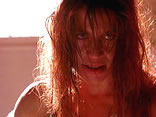
I told myself I had to write the script just like there had never been a first film. The sequel had to be a story about someone who encountered something nobody else believes, like the opening scene of Invasion of the Body Snatchers, where Kevin McCarthy swears he’s seen something shocking, and nobody believes him; then he starts telling the story.
“The first time we meet Sarah in Terminator 2, she’s locked up in a mental institution, and that raises the real question – is she really crazy? The advantage of doing a sequel is that you can play games you can’t play in the original. For example, I know the audience knows that The Terminator is real. So they’re not going to think she’s crazy. But the question still remains: Is she crazy? Has the past ordeal made her lose touch with reality?
“What I found so interesting is that a lot of people made the mistake of thinking I was presenting Sarah Connor as a role model for women. Nothing could be farther from the truth. I wanted people to invest in her emotionally, to feel sorry for her, because she had been through such hell. And there were a lot of people who made a straight-line extrapolation from Ripley (the Sigourney Weaver character in Aliens), to Sarah.
“They’re very different characters. Ripley’s been through a trauma, but she had certain innate characteristics of leadership and wisdom under fire; she’s a true hero. Sarah’s not really a hero. She’s an ordinary person who’s been put under extreme pressure, and that makes her warped and twisted, but at the same time strengthened, in a sad kind of way. The initial image I had of her was to have a big scar running down the side of her face, and we actually did makeup tests with scars, but it would have been a real nightmare to deal with a scar like that in production on a day-to-day basis. I really wanted her to look like Tom Berenger in Platoon. And Linda was up for it, because the last thing she had done was playing Beauty in Beauty and the Beast for three years. It’s a tribute to her as an actor that she was able to pull of that severity without the help of any makeup whatsoever.
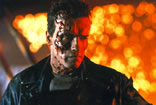
“That made me very nervous. I knew the ‘bad guy being the hero’ would get me into some pretty dangerous territory, morally and ethically. I absolutely refused to do another film where Arnold Schwarzenegger kicks in the door and shoots everybody in sight and then walks away. I thought there must be a way to deflect this image of the bad guy as hero, and use what’s great about the character. I didn’t know exactly what to do, but I thought the only way to deal with it would be to address the moral issues head-on.
“The key was the kid. Because it’s never really explained why John Connor has such a strong moral fiber.
“For me, John was pushed by the situation when he sees The Terminator almost shoot the guy in the parking lot. I think everybody invents their own moral code for themselves, and it usually happens in your teens based on what you’ve been taught, what you’ve seen in the world, what you’ve read, and your own inherent makeup.
“So, I started asking myself what is it that makes us human? Part of what makes us human is our moral code. But what is it that distinguishes us from a hypothetical machine that looks and acts like a human being, but is not?
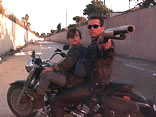
“I thought the best way to deal with this was not be coy about it and hope it slides by, but to tackle it head-on and make this a story about why you can’t kill people.
“Essentially, you’ve got a character associated with being the quintessential killing machine; that is his purpose in life. Devoid of any emotion, remorse, or any kind of human social code, he suddenly finds himself in the strangest dilemma of his career. He can’t kill anybody, and he doesn’t know why. He’s got to figure it out. He’s got to, because he’s half human. And he figures it out at the end. The Tin Man gets his heart.
“Once I clicked into that, I saw what the whole movie was going to be about.”
END OF PART I
(Note: It might be interesting to watch Terminator 2: Judgment Day again, and take note of all these issues James Cameron had to deal with.)

Comments are closed.